Latest Contributions
My love for nature

Vinod Goel was born and brought up in the small town of Palwal, Haryana. He attended the Sainik School Balachadi in Jamnagar. In 1982, he joined the Indian Revenue Service (Customs and Central Excise).
Vinod’s intense desire to own a camera from his childhood led to his deep interest in studying wildlife in natural surroundings. Over the years, he also developed a fascination for ‘local’ birds in neighbourhood conditions. Thus his basic philosophy: ‘uncommon Behaviour of common birds‘.
Vinod, supported by his family, has become a well-known photographer in India and abroad.
My love for nature begins early
I left my home and parents at the tender age of 11 years for schooling in a hostel at Sainik School Balachadi in Jamnagar, a district of Gujarat in 1967.
My father owned a kirana shop in Palwal town in Haryana. We are three brothers and one sister. Being the eldest in the family and good at studies, I was sent to the hostel through a competitive exam in 1966.
I had the most enriching experience in my school days as it was a wonderful exposure. More over, being in a Sainik school, top most personalities from defence forces too regularly visited our school.
Even during my school days I wanted to own a camera as our school was on the sea shore and we could observe nature changing on a daily basis. At that point of time, the family did not have enough resources to buy even the cheapest camera from the market.
I remember during my college days at my hometown at Palwal I used to clip out beautiful images which were published in the daily newspaper.
Later on as a student of engineering at the Indian Institute of Science (I.I.Sc., locally known as the "Tata Institute") in spite of the main focus being on studies, we enjoyed the best of the times. Climate at Bangalore was so cool those days that we didn’t even have fans on the student campus from 1975 to 1978.
Only after joining the Department of Customs and Central Excise, I bought my first camera — a Yashica Electro 35 from Burma Bazaar at Chennai in the year 1983.
That was the beginning. After that I started clicking photographs wherever we went on tours from our training institute. In those days, one had to buy a film roll of 36 at a high price. The cost of printing and developing the film roll was expensive too.
As time passed and I went in the department from one posting to another, there was hardly any time to pick up a hobby or follow one's passion. One had to look after the needs of the family as well as those of the department.
But my camera accompanied me during all my travels whether it was a family trip or an official trip. I loved capturing candid shots of people and anything fascinating in nature such as flowers, landscapes, sunrise etc.
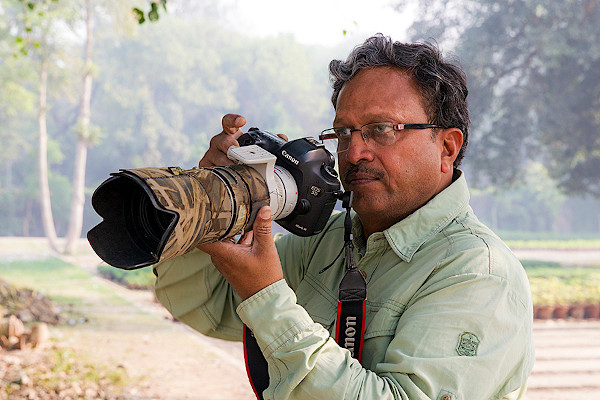
Vinod Goel with a camera by Canon that he uses with various bodies (like the Mark 4, Mark 3, 1DX), prime lenses (like 400 f2.8, 600 f5.6) and telephoto lenses (like 16-35mm f2.8, 70-200mm f2.8).
Call of the Wild
My posting to Raipur was a turning point in my life. On promotion as Commissioner in the year 2002, I was posted at Raipur — the capital of the newly created state of Chhattisgarh. There, I had plenty of time on hand as I had to leave my family at Delhi as both of my children were studying at Modern School.
Looking after the welfare of the children became the responsibility of my better half, Sangeeta. She shouldered the responsibilities perfectly.
I was able to visit the family only rarely as air travel was very costly; only Indian Airlines operated between Raipur and Delhi.
My very first visit to Kanha National Park in Central India (Madhya Pradesh) in April 2004 ignited my passion for wildlife which has not lessened since then.
During the last 15 years I have been to more than 50 National Parks and wildlife sanctuaries in India.
Initially, I visited wildlife sanctuaries in the states of Chhattisgarh, Madhya Pradesh and Uttarakhand. By now, I have covered almost all the national parks of Madhya Pradesh, Rajasthan, Maharashtra, Uttar Pradesh, Uttarakhand, Bihar and West Bengal.
Out of 50 tiger reserves in the country, I have been to more than 20 and photographed tigers in 12 of them. Apart from tigers, I feel blessed to have opportunities to capture some of the rarest moments in the wilderness of our country.
Photography Exhibitions
My first exhibition, titled “Tiger’s Realm,” was held at the India International Centre, New Delhi in December 2011. It was followed by another named “Jewels of the Wild” which was held at Open Palm Court, India Habitat Centre, New Delhi along with my son, Bharat.
In May 2012, the Union Ministry of Environment and Forests invited my son Bharat and I to hold an exhibition during the World Conference on Global Tiger Recovery Program at New Delhi.
In April 2016, the Union Ministry of Environment, Forest and Climate Change invited us to hold a photo exhibition for the delegates of the 3rd Asian Ministerial Conference for Tiger Conservation at India Habitat Centre, New Delhi.
Our photographs have been published in several books, namely ‘Wild Fire’, ‘Winged Fire’ and ‘Saving Wild India - A Blue Print for Change’ by the well-known conservationist and writer, Valmik Thapar. Another photograph appeared in the book named ‘Tadoba Inheritance’ by Sanctuary Asia magazine.
For the last 5 years, our photographs have been published in the annual calendar of World Wildlife Fund India (WWF India). For the first time, two photographs have appeared in the Wildlife Trust of India calendar for the year 2020.
I remember when I got transferred to Delhi as Commissioner of Customs Airport and Air Cargo (Imports) in March 2010, I had many responsibilities in office and got little time to move out in the wild.
Therefore, I decided to utilize my early mornings roaming the neighbourhood. This was a rewarding experience.
I soon realised that I could study the behaviour of local resident birds such as Yellow footed green pigeon, shikra, brown headed barbet, Asian Koel, etc. at leisure.
I spent my weekends visiting the national parks around Delhi. These visits also helped me to de-stress from the pressures of my office.
From 2013, based on an article in the Daily News paper of Delhi, I came to know about the existence of Sunder Nursery opposite World Heritage Site, Humanyun Tomb in New Delhi.
The wilderness of the place attracted my attention as I found a number of peacocks and other resident birds namely Indian Grey hornbill, purple sunbird, white throated Kingfisher, Yellow footed green pigeon, Asian Koel, Pied Crested Cuckoo, varieties of Myna, etc.
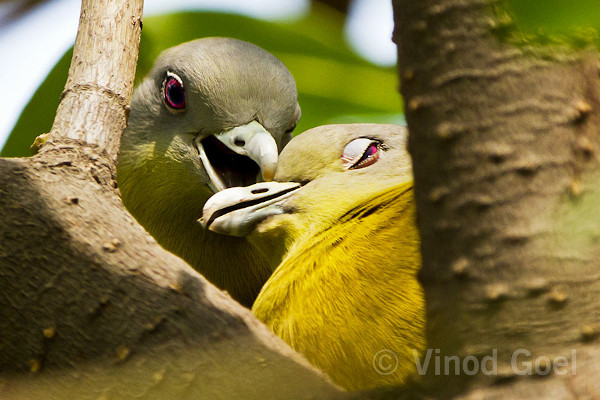
Yellow-footed green pigeons. Photo credit: Vinod Goel. Copyright: Vinod Goel
I soon realised that the ‘birders’ in India hardly deal with the behaviour of local resident birds.
Thus, I focused my work on the behaviour of local birds as my basic philosophy dwells on ’Uncommon Behaviour of Common Birds’.
To a large extent I have been blessed by the Almighty as I have recorded courtship and mating of local birds including peafowls, brown headed barbet, Asian Koel and a few others.
From 2013 I started sharing my wildlife experiences. My articles started appearing in reputed magazines such as ‘Airports India’, ‘Rail Bandhu’ (monthly magazine in India’s premier trains namely Rajdhani Express, Shatabadi Express and Duronto Express), ‘Shubh Yatra’ (the inflight magazine of Air India), ‘Exotica’ (magazine distributed in five star hotels), and ‘Terrascape,’ etc.
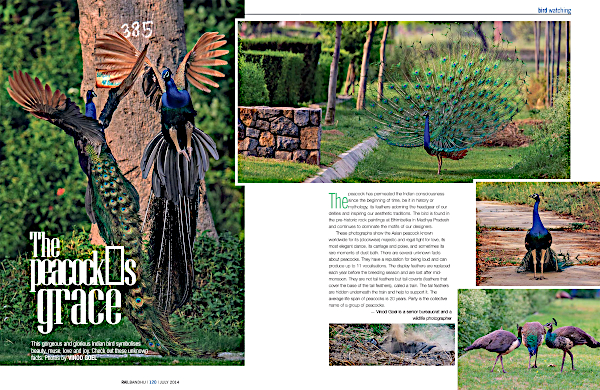
An article in the Rail Bandhu magazine, July 2014 edition featuring photographs of peacocks. Photo credit: Vinod Goel. Copyright: Vinod Goel
After superannuation in January 2015, nature and wildlife has become the centre of my life. Through my articles and photographs I try to make people aware of the rich wildlife heritage of the country and exhort them to protect the same for the benefit of future generations.
I love to capture the most uncommon behaviour of the common species and that too in our daily life. Normally, we tend to ignore the flora and fauna around us. But it is my goal to spread awareness about the diversity present in our neighbourhood. My aim is to convert it a global movement.
During our visits to the jungle I also realised that most of the wild lifers / nature lovers were interested in tiger photography and that of other exotic species such as the Asian Elephant and the leopard, including Snow Leopard.
There was hardly anybody working on the peacock, our National bird, about whom we had heard that they do not mate and that is the reason why their feathers adorns Lord Krishna’s head.
Although I had seen some videos on the mating of peacocks, I wanted to see this conjugation through my own eyes.
No doubt its colourful feathers attracted my attention but initially it was to check out the truth personally about the myth that the peacocks as a species do not mate. This has been the prevalent view for many generations.
The Peacock
Generally the peacocks that we observe in our country are blue and are known as Blue Peacock. In fact the Blue Peacock is the male and the peahen is greyish with a yellowish tinge. Both are known together as Peafowl.
They are known for their iridescent tails. During their mating dance, the tail feathers spread out and one can observe the eyespots called ocelli. They are the largest pheasant in the world. They belong to the family of Phasianidae. In India, the peacock was declared the national bird on 1st February, 1963 on the basis of its presence in most parts of our country.
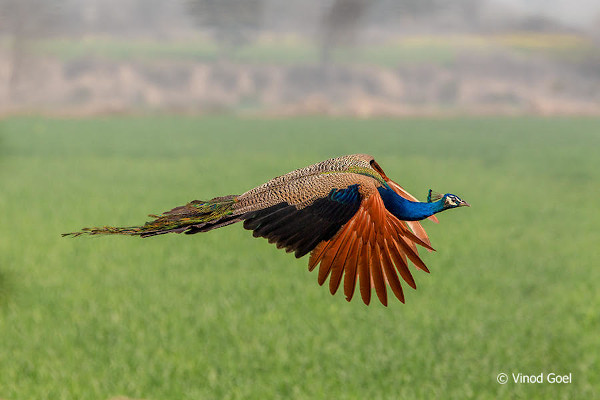
A peacock in flight. Photo credit: Vinod Goel. Copyright: Vinod Goel
No doubt it is one of the most colourful birds in the world. The peacock has been admired by humans and kept as a pet for thousands of years. Even when Alexander the Great left India after the war, he took a number of them to his country. Generally a peacock’s life is about 20 years in the wild but in a protected environment such as a zoo, they are known to have lived up to 40 years.
Peafowls live in forested areas where they roost on trees. In urban areas such as cities, they nest on the ground. However, where ground space is limited they make nest on the terraces of the buildings.
These nests have been observed at the first floor at India International Centre adjacent to the Lodi Gardens in Delhi and on terraces at Gurugram.
My desire to observe the mating of a peahen and a peacock directed me to concentrate my energy on this bird. I started observing them almost on daily basis from 2013 at Sunder Nursery. After observing them for a period of 3 years I got my first mating shot on June 23, 2016.
However I was not satisfied. Then again I got a presentable shot on 8th August, 2016. Based on this recording, the Hindi daily newspaper, Panjab Kesri from Delhi, published a story that peahens do not get pregnant by drinking the tears of a peacock; they do mate like other birds and animals.
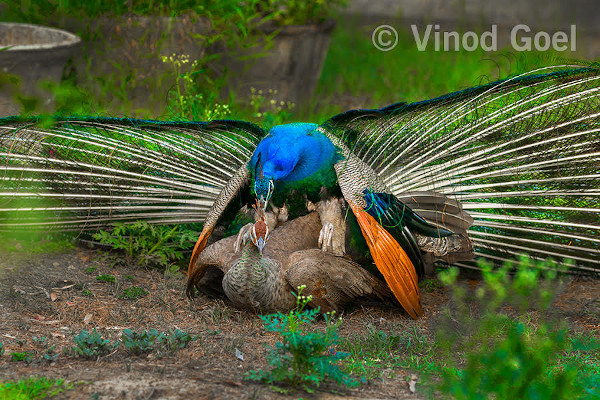
Peafowls mating at Sunder Nursery, New Delhi in 2016. Photo credit: Vinod Goel. Copyright: Vinod Goel
This was the most difficult shot which took about 3 years of my life. I have not stopped yet as every year I am trying to get mating shots during every breeding season which starts from March in Delhi and continues up to September/October.
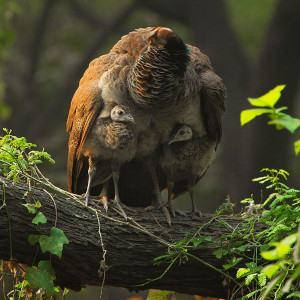
Peahen with chicks. Photo credit: Vinod Goel. Copyright: Vinod Goel
Why it is so difficult to observe seeing peafowls mating?
I have been observing courtship and mating of various birds (mainly resident birds) for more than 9 years in different regions of the National Capital Region.
The most difficult is to record the mating of a peacock and a peahen because it lasts for just 6 to 13 seconds at the most. Hence, unless one is focused and ready to observe and record, one may not succeed. This is the most important factor why mating has not been observed by naturalists who visit parks and wildlife sanctuaries regularly.
The intervening period which I spent with them almost on daily basis at Sunder Nursery and other parks such as Aravali and Yamuna Diversity Parks at Delhi gave me an insight into other resident birds such as Indian Grey Hornbill, Yellow footed Green Pigeon, Asian Koel, Golden Oriole, Pied Crested Cuckoo and others.
Tiger Photography
Most people who go for jungle safari are disappointed as they do not even get a glimpse of the most elusive cat in the natural habitat, as their numbers have reduced from a lakh at the beginning of the 20th century to a few thousand now.
At present, there are about 2,967 tigers in our country. Although there are about 12 more countries in addition to India, one can observe tigers in India in the wild only with effort and good luck.
Under these circumstances, to get a good picture of the tiger which gets appreciation from the other photographers is a blessing.
When I captured an image of a tiger at kill of Sambhar at Rajaji National park in the state of Uttarakhand, Shri Valmik Thapar, well-known tiger conservationist, told me that I was the first wildlife photographer who had recorded such a beautiful shot of the tiger from Chilla Range at Rajaji Tiger Reserve.
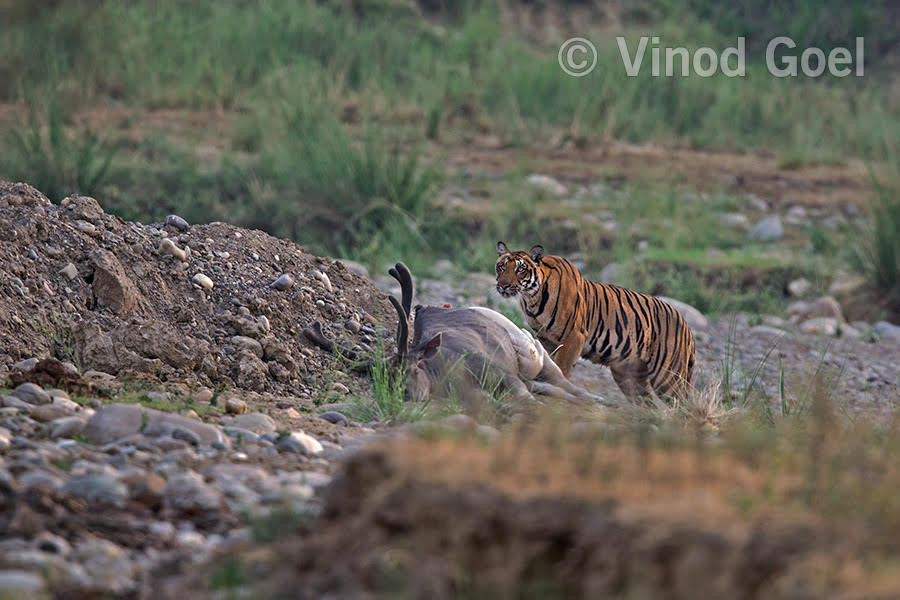
Tigress with the kill. Photo credit: Vinod Goel. Copyright: Vinod Goel
Another image of two tigers sitting on the boulder at Pench Tiger Reserve (actors of the topmost documentary on tigers, “Tigers - Spy in the jungle“).

Tigers resting on a boulder. Photo credit: Vinod Goel. Copyright: Vinod Goel
My photograph of a family of five tigers at the waterhole at Tadoba Andhari Tiger Reserve is a signature image from my treasure trove.
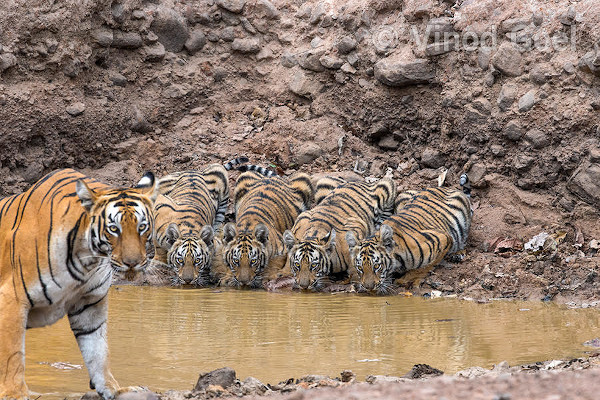
A family of five tigers at the waterhole at Tadoba Andhari Tiger Reserve. Photo credit: Vinod Goel. Copyright: Vinod Goel
My family members
My family members have always supported my wildlife forays and soon came to develop their own passion for it.
Mrs. Sangeeta Goel (1964 to 2018)
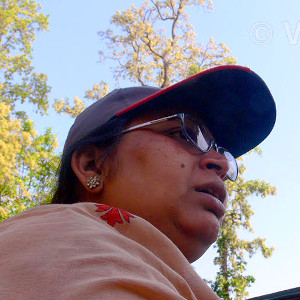
Sangeeta Goel
Sangeeta came into my life in the year 1984 and has been my travel partner in various excursions throughout the country especially hill stations and religious places. However from 2004, we started visiting various wildlife parks of the country together. She was very involved in watching the tigers living their life in the wild. She felt restless when she could not visit a wild life hotspot for a few months at a stretch.
I remember in some of the most rare images captured by me, she played a most important role. One such image clicked at Sariska Tiger Reserve in Rajasthan is exhibited at the National Tiger Conservation Authority office under the Union Ministry of Environment and Forests at New Delhi.
I was ‘shooting’ a peacock at a water body. Sangeeta told me to shoot a sambhar fawn having milk from the mother. I moved my camera and in a minute a male sambhar came and started having milk from the female.
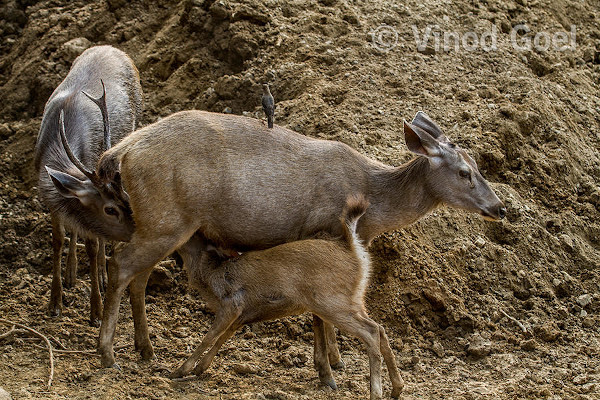
A male sambhar having milk from the female sambhar at Sariska Tiger Reserve in Rajasthan. Photo credit: Vinod Goel. Copyright: Vinod Goel
This was a natural history ‘moment’ recorded by anybody in the world. After the safari was over, it was confirmed by Dr. K. Shankar from Wildlife Institute of India, Dehradun that he has been working at the same park for the last 28 years and this behaviour is unique and rare.
During our safari at Tadoba Andhari Tiger Reserve in 2010 we observed a ‘langur’ monkey drinking water like a human being along with another monkey in the normal way.
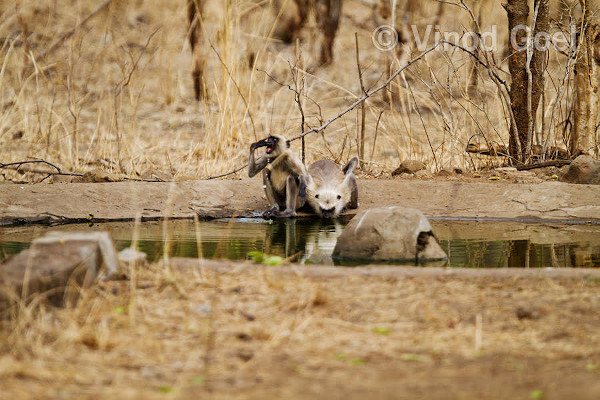
A ‘langur’ monkey drinking water like a human being at Tadoba Andhari Tiger Reserve in 2010. Photo credit: Vinod Goel. Copyright: Vinod Goel
I have many other memories of such moments where Sangeeta was my partner in capturing rare natural history moments.
Nitya Goel Aggarwal

Nitya Goel Aggarwal
My daughter Nitya is married and based at Mumbai. An interior designer by profession, she changed her career to pursue her passion for wildlife and nature conservation.
Her love for nature developed since childhood while exploring various places with me during my postings in various parts of India. She believes in promoting eco-tourism and conservation of nature. She has a good understanding of the importance and need of instilling love for nature at a young age.
She believes holistically in the principle of Re-use, Reduce and Recycle in all aspects of life and encourages everyone else to do the same.
Based in Mumbai, her expertise comes from her own experience in nurturing her son, Ayaan, into wildlife and a nature buff at a very young age.
Ayaan, 8 years of age and the youngest in the family, has seen the ‘big five’ of Indian wilderness, namely the Asiatic elephant, the royal Bengal tiger, the leopard, the one-horned rhino and the Asiatic lion.
Apart from an expert team at her disposal for carrying out various nature tours, Nitya independently leads groups in Mumbai for flamingo watching. At present she is well-known amongst the Mumbaikars for flamingo watching, marine walks, birding and other nature trips in and around Mumbai.
Bharat Goel
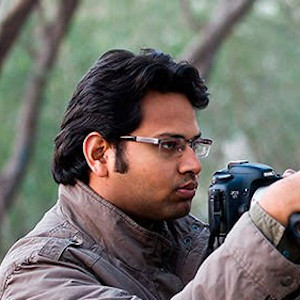
Bharat Goel
My son, Bharat, is based at Delhi. At an age when youngsters like to spend time partying with friends, he prefers to spend his free time with nature.
During his schooling in Modern School, Barakhamba Road, New Delhi, Bharat chose photography as his hobby without realizing that one day his hobby would become his life’s biggest passion.
During summer vacations of 2004 when he first visited the Kanha National park with me, he fell in love with nature, flora and fauna.
During his engineering degree at Bhilai Institute of Technology at Durg in Chhattisgarh, his interest in wildlife developed in a big way as he got a chance to visit nearby wildlife sanctuaries and national parks such as Udanti, Sitanadi, Nagzhira, Pench, Kanha and Tadoba Andhari Tiger Reserve.
Through college campus placement, he got into Tata Consultancy Services Ltd. in 2010. But his love for the wildlife forced him to leave the company within a year as he wanted to learn and contribute more towards the wildlife.
No doubt his father (that’s me) inspired him into the new world of wildlife and nature with the visit to Kanha Wildlife sanctuary in 2004. He has since then carried on his passion forward.
He has now established a new company known as Wild Nest Travel and Photography Pvt. Ltd., having offices at Ghaziabad.
The firm curates customized trips to various wildlife destinations of the country as well as cultural, architectural and religious tours incorporating the personal experience of traveling and hence providing popular itineraries.
Comments
Congratulations to Shri Vinod Goyal for his superb photographs
and passionate pursuit of animals in the wild and birds in NCR area .All this has given rich haul of unique photos-treasure for posterity.All kudos to him
Happy
What a story and what lovely photographs. Th evolution of your family from a small kirana shop to world-class activities is also fascinating
Vinod Sir,
Vinod Sir,
I am proud to have a person of your stature as my senior. I have, during our school days, seen you as a sprinter, always delivering the best performance that became your trademark as you perused your career as an IRS Officer and as a photographer. I have an added pleasure to have been close to you during our school days and I always feel elated whilst interacting with you.
The passion and the flare have assumed genetic proportion and I am sure that you will be touching the top and remaining there in the field of your passion of photography.
Hiten Shah.
Passion perfect pictures
Passion perfect pictures providing uniqueness to the family in the field of environment. What a fantastic real time account by Vinod, my batchmate from the Service.
Salute your dedication
Enjoyed going through your article and the pictures. Great job with high dedication.
Passion beyond imagination
Great going vinod. Proud to be your friend. Your passion for wild life is really great and it was imbibed fully by all your family members. The incident surprised me even till today when bharat left the job to accept the same passion . Congratulations
Add new comment